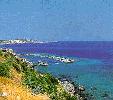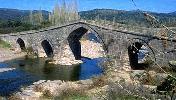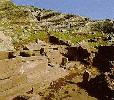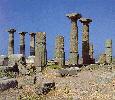| Assos (Behramkale)... |
|
Assos was originally founded by Aeolian colonists from Lesbos in the 7th century BC. In the 6th
century BC it came under the rule of the Lydians and with their defeat at the hands of the Persians in 546 BC, the city
came under Persian rule. Ariobarzanes, the Persian governor who rebelled against King Artaxerxes was defeated at Assos in
365 BC and he was replaced by Euboulos, a prominent banker. He was succeeded by the eunuch Hermias, one of Plato's students
and it was because of this association that Hermias's friend Aristotle stayed with him for three years at Assos (348 - 345
BC). In 334 BC Assos was taken by Alexander, and the city was part of the Pergamon kingdom from 241 to 133 BC after which
it came under Roman rule. Assos was ruled by Byzantium after 395 AD. During this period it was known as Makhram. (It is
believed that "Behramkale", the name of the village above Assos, is derived from this.) Assos became an Ottoman
possession during the reign of Murad I (1359 - 1389). The acropolis was defended by a double wall. The inner walls appear
to have been repaired in Medieval and Ottoman times and have been restored. Beside them is a mosque built during the reign
of Murad I. The bridge below, which is no longer usable, was also built in the 14th century. The Temple of Athena
was built on a site with a magnificent view overlooking the sea at a height of 238 meters. At present only a few of the
temple's columns are standing but restoration work is in progress. The temple was built some time around 530 BC. It is
constructed of andesite rather than marble and has 6 by 13 columns and measure 14 by 30 meters in size. The acropolis is
surrounded by a wall three kilometers in length. These walls are skillfully constructed of stone and reach 20 meters in
height in some places. There are two big gates, one on the west and another on the east, as well as seven smaller gates.
The walls were reinforced with numerous towers and were built in 365 BC (the polygonal walls we see here and there predate
the 4th century however.) We shall begin our tour of the city proper by entering through the main gate on the
west. Just outside the western gate is a necropolis containing tombs from Hellenistic and Roman times. The arched structure
here is the monumental tomb of Publius Varius. Entering through the gate we see the defensive towers located on either side.
On the left side after entering the gate is the Assos gymnasium. Measuring 32 by 40 meters, this gymnasium is the form of
a courtyard surrounded on four sides by colonnades.
|
|

|










